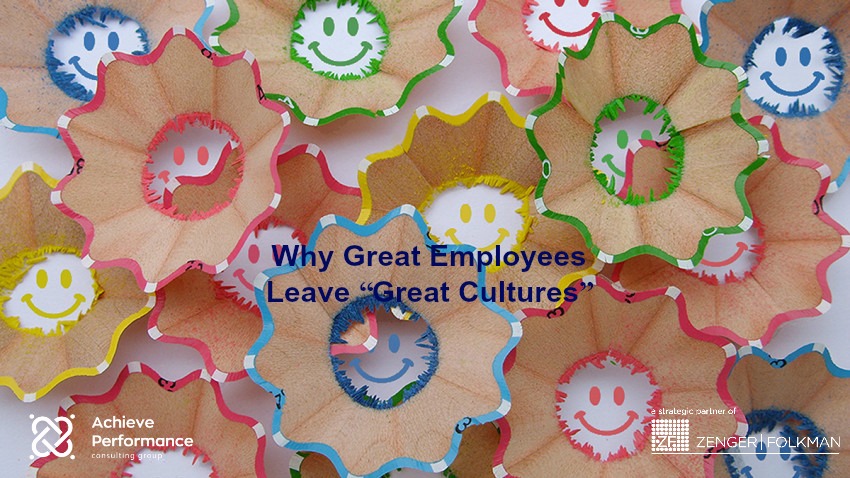Why Great Employees Leave “Great Cultures”

Position versus Persuasion Power

In Conversation with Edgar Schein: Answering Three Common Questions about Culture

Scared and shocked team of young business men and women under boss pressure. Concept horror and fear of the boss. Collage with big shoe of boss

Why Great Employees Leave “Great Cultures”
“We have a great culture.” We have all heard it. We have all said it. But what does that mean?
Ping-Pong tables, free meals, and beer on tap? No.
The promise of being part of a hip, equity-incentivized, fast growing team? Closer, but still no.
Culture is often referred to as “the way things are done around here.” But to be useful, we need to get more specific than that. I’ve been working in HR for over twenty years, and the best companies I’ve worked with have recognized that there are three elements to a culture: behaviors, systems, and practices, all guided by an overarching set of values. A great culture is what you get when all three of these are aligned, and line up with the organization’s espoused values. When gaps start to appear, that’s when you start to see problems — and see great employees leave.
Denise sees possibilities in people. She believes that people want to take pride in their work and be part of a winning team. She’s learned that motivation or morale problems are often rooted in leaders failing to engage people in the broader ideals of the organization. As more people search for meaning in their lives and in their work, this disconnect creates much of the frustration and lack of purpose found in so many workplaces today. Denise works hard at connecting people to her organization’s vision, values, and purpose. Denise’s high energy and optimistic attitude sets a strong and positive emotional tone throughout her organization. People are inspired to face tough problems with confidence and teamwork.
These gaps can take many forms. A company might espouse “work-life balance” but not offer paid parental leave or expect people to stay late consistently every night (a behaviors-system gap). You might espouse being a learning organization that develops people, but then not give people the time to actually take classes or learn on the job (system-behaviors gap). Maybe your company tells people to be consensus-builders, but promotes people who are solely authoritative decision makers (behavior-practices gap).
Gaps like these are never solved by turning culture over to a Chief Culture Officer or pulling together culture committees. Likewise, inspirational leadership, the repetition of value statements, and letting people be themselves are important, but they are by-products of a healthy culture, not the drivers of one.
How, then, do we repair a flagging culture? A place to start is by reviewing the behaviors, systems, and practices in place in your company.
Behaviors
A common culture-building practice is the creation of value statements. But the real test is how leaders behave; how they enact these values, or don’t. People watch everything leaders do. If leaders are not exhibiting the behaviors that reflect the values, the values are meaningless.
Employees also need clarity, but of a different kind. Every employee I have managed would give up their so-called perks for one thing: clear expectations. Given your organizational values, which behaviors consistently get rewarded? Which behaviors lead to promotion?
Spend the time identifying the behaviors and skills that express each of your organizational values. For example, if I saw someone exemplifying the value of “teamwork,” what would she be doing? What would she not be doing? One organization might identify teamwork behavior as “collaborates effectively through helping others.” Another might interpret a teamwork behavior as “collaborates effectively through encouraging productive disagreements.” Both can be done, but which behavior is expected and encouraged at one company vs. another?
Clarifying expected behaviors for employees holds leaders accountable as well. Does a manager value face-time more than outcomes? Is a leader always ten minutes late to a meeting? How often does starting a meeting five minutes late roll into people showing up unprepared? These are the real-world behaviors of culture and values. Before we realize it, the organization becomes known for late meetings, face-time, or reactive and apathetic leadership. Employees become reactive. And then we wonder why we have an attrition problem.
When expected behaviors are clear, we can focus our time on practicing those behaviors rather than spending our time on trying to identify them. Accountability becomes easier to measure and success easier to attain.
Systems Every process that is created, every system installed, every technology that is used, every structure that is designed, every job title that is given will reinforce or dilute the culture. There are five key systems that are important to the overall cultural system:
Hiring. Clarity around behavioral expectations allows us to bring much-needed clarity to the hiring process. Instead of the common default to hiring for “cultural fit” — which in practice is usually an excuse for hiring people we find likable or similar to us — we can look for behaviors that are cultural complements. This moves us away from the tendency to hire people who think the same and towards a company built on diversity of backgrounds, perspectives, and ideas that complement culture while also enriching it.
Strategy and goal setting. These activities do two things, culture-wise: rally people around similar goals while also providing guidance on outcomes employees are expected to produce.
Assessing. How are behaviors assessed? How often are they reviewed? Is feedback shared consistently, and is it weighted based on who said it? Lack of trust or questions about what behavioral standards will be used will create political and fear-based environments.
Developing. When employees feel that professional development, feedback assessments, or engagement surveys are irrelevant, it’s usually because the questions don’t tie back to what the organization actually reinforces and rewards. Culture problems can also arise when a “safe learning environment” turns into a way to punish employees for low scores rather than a way to help them grow.
Rewarding. What is the criteria to become a manager, director, vice president? What are the expected behaviors that earn a person said title? What technical and leadership skills are needed? These are all expressions of culture and values, but too often they are perceived as random. Employees do not have to be concerned about being friends with the CEO, competing with each other, and other political challenges when these processes are viewed as transparent and fair.
A good culture sets these processes up so they feed into and off of each other.
Practices
Practices include everything from company events, running meetings, feedback processes, to how decisions are made.
Do you have repeatable decision-making processes in place? Are meeting participants expected to be collaborative and consensus-driven, or is some conflict OK? What should managers talk about in performance reviews?
Do you have repeatable decision-making processes in place? Are meeting participants expected to be collaborative and consensus-driven, or is some conflict OK? What should managers talk about in performance reviews?
Great organizations and leaders know that the culture stuff is the hard stuff. Culture takes time to define. It takes work to execute. Yet, if the time is spent (1) really understanding the behaviors expected throughout the organization; (2) identifying the systems and processes that will continue to help those behaviors be expressed and sustained; and (3) shaping practices that help employees and the organization become better, then you can close your culture gaps, and stop your best people from saying, “I know it’s a great culture, but I am leaving.”
Read more
Source: HBR



